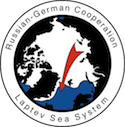 Task 5B
Task 5B
Holocene sea-ice variability, water-mass distribution and sea-level history in the western Laptev Sea (TRANSDRIFT XXV)
Task B will supply reliable paleoenvironmental reconstructions for the western Laptev Sea shelf and Vilkitsky Strait for the Holocene period with particular emphasis on warm climatic intervals in the pre-instrumental era to compare present and pre-industrial environmental states. The research area is a key region for understanding past water-mass exchanges and time-transgressive changes in sea-ice extent under various natural forcings.
Paleoenvironmental parameters and the temporal and spatial variations to be investigated will comprise sea-ice coverage and water-mass properties (temperature, salinity), the character of important water masses (Atlantic Water, river runoff), and the role of sea-level rise for, e.g., the flow through Vilkitsky Strait.
To perform the reconstructions, a complex set of proxy data will be established from available sediment cores and jointly evaluated by the participating teams. Surface sediment samples will be analyzed in order to reveal the relationship between modern environmental parameters (from Work Packages 1 and 2 and published sources), sediment characteristics (e.g., biomarkers) and the taxonomic composition of organisms used in paleoreconstructions. Available marine sediment cores will be sampled at high resolution and analyzed for lithology, planktic and benthic microfossils, biomarkers, and stable isotope composition of carbonate tests. Based on AMS14C datings of carbonate microfossils, a detailed age model will be established as the backbone for paleoenvironmental reconstructions.
The scientific outcome is expected to be a multiproxy-based reconstruction of Holocene changes in environmental parameters in the research area, with special attention to warm periods that may serve as possible analogs of the future Arctic environment under progressive global warming.
The team from Moscow State University will perform counts of ice-rafted debris and benthic and planktic microfossils in the investigated sediment cores. It will study and evaluate the da¬ta from microfossil assemblages. The team from GIN RAS will study benthic and planktic microfossil assemblages in surface sediment samples and establish the relation to modern environmental parameters. The team from Mainz Academy will establish stable isotope records (?18O, ?13C) of carbonate microfossils in the sediment cores and surface samples and elaborate age models based on AMS14C datings (see below for a detailed description of the research in Task 5B for which the CATS scientists apply for funding on the German side). The AWI team will establish records of sea-ice biomarkers and organic geochemical data from sediment cores and surface samples.
Task coordinator |
|
| Ekaterina Taldenkova | Moscow Lomonosov State University |
Key collaborators |
|
| Henning Bauch | Alfred Wegener Institute Helmholtz Centre for Polar and Marine Research |
| Natalya Chistyakova | Moscow Lomonosov State University |
| Heidemarie Kassens | GEOMAR Helmholtz Centre for Ocean Research |
| Yaroslav Ovsepyan | Geological Institute RAS |
| Robert Spielhagen | Mainz Academy of Sciences, Humanities and Literature |
| Ruediger Stein | Alfred Wegener Institute for Polar and Marine Research |
